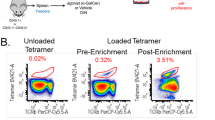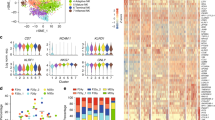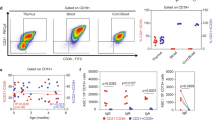Abstract
Natural killer (NK) cells develop in the bone marrow, but their in vivo stages of maturation, expansion and acquisition of receptors that guide target cell specificity are not well defined. We describe here such stages of development. We also show that developing NK cells actively proliferate at a phenotypically distinguishable immature stage after they have acquired expression of Ly49 and CD94-NKG2 receptors. These studies provide a developmental framework for NK cell maturation in vivo and suggest the possible involvement of the Ly49 and CD94-NKG2 receptors themselves in modulating expansion of NK cell populations with a given NK cell receptor repertoire.
This is a preview of subscription content, access via your institution
Access options
Subscribe to this journal
Receive 12 print issues and online access
$209.00 per year
only $17.42 per issue
Buy this article
- Purchase on Springer Link
- Instant access to full article PDF
Prices may be subject to local taxes which are calculated during checkout






Similar content being viewed by others
References
Raulet, D.H., Vance, R.E. & McMahon, C.W. Regulation of the natural killer cell receptor repertoire. Annu. Rev. Immunol. 19, 291–330 (2001).
Lanier, L.L. Face off-the interplay between activating and inhibitory immune receptors. Curr. Opin. Immunol. 13, 326–331 (2001).
Williams, N.S. et al. Natural killer cell differentiation: insights from knockout and transgenic mouse models and in vitro systems. Immunol. Rev. 165, 47–61 (1998).
Carlyle, J.R. et al. Identification of a novel developmental stage marking lineage commitment of progenitor thymocytes. J. Exp. Med. 186, 173–182 (1997).
Ikawa, T., Kawamoto, H., Fujimoto, S. & Katsura, Y. Commitment of common T/Natural killer (NK) progenitors to unipotent T and NK progenitors in the murine fetal thymus revealed by a single progenitor assay. J. Exp. Med. 190, 1617–1626 (1999).
Rosmaraki, E.E. et al. Identification of committed NK cell progenitors in adult murine bone marrow. Eur. J. Immunol. 31, 1900–1909 (2001).
Suzuki, H., Duncan, G.S., Takimoto, H. & Mak, T.W. Abnormal development of intestinal intraepithelial lymphocytes and peripheral natural killer cells in mice lacking the IL-2 receptor β chain. J. Exp. Med. 185, 499–505 (1997).
Lodolce, J.P. et al. IL-15 receptor maintains lymphoid homeostasis by supporting lymphocyte homing and proliferation. Immunity 9, 669–676 (1998).
Kennedy, M.K. et al. Reversible defects in natural killer and memory CD8 T cell lineages in interleukin 15-deficient mice. J. Exp. Med. 191, 771–780 (2000).
Kim, S., Iizuka, K., Aguila, H.L., Weissman, I.L. & Yokoyama, W.M. In vivo natural killer cell activities revealed by natural killer cell-deficient mice. Proc. Natl. Acad. Sci. USA 97, 2731–2736 (2000).
Williams, N.S. et al. Generation of lytic natural killer 1.1+, Ly-49− cells from multipotential murine bone marrow progenitors in a stroma-free culture: definition of cytokine requirements and developmental intermediates. J. Exp. Med. 186, 1609–1614 (1997).
Williams, N.S., Kubota, A., Bennett, M., Kumar, V. & Takei, F. Clonal analysis of NK cell development from bone marrow progenitors in vitro: orderly acquisition of receptor gene expression. Eur. J. Immunol. 30, 2074–2082 (2000).
Arase, H., Saito, T., Phillips, J.H. & Lanier, L.L. Cutting edge: the mouse NK cell-associated antigen recognized by DX5 monoclonal antibody is CD49b (α2 integrin, very late antigen-2). J. Immunol. 167, 1141–1144 (2001).
Sivakumar, P.V. et al. Cutting edge: expression of functional CD94-NKG2A inhibitory receptors on fetal NK1.1+Ly-49− cells: a possible mechanism of tolerance during NK cell development. J. Immunol. 162, 6976–6980 (1999).
Salcedo, M. et al. Role of Qa-1(b)-binding receptors in the specificity of developing NK cells. Eur. J. Immunol. 30, 1094–1101 (2000).
Dorfman, J.R. & Raulet, D.H. Acquisition of Ly49 receptor expression by developing natural killer cells. J. Exp. Med. 187, 609–618 (1998).
Smith, H.R. et al. Nonstochastic coexpression of activation receptors on murine natural killer cells. J. Exp. Med. 191, 1341–1354 (2000).
Roth, C., Carlyle, J.R., Takizawa, H. & Raulet, D.H. Clonal acquisition of inhibitory Ly49 receptors on developing NK cells is successively restricted and regulated by stromal class I MHC. Immunity 13, 143–153 (2000).
Raulet, D.H. et al. Specificity, tolerance and developmental regulation of natural killer cells defined by expression of class I-specific Ly49 receptors. Immunol. Rev. 155, 41–52 (1997).
Trinchieri, G. Biology of natural killer cells. Adv. Immunol. 47, 187–376 (1989).
Dokun, A.O. et al. Specific and nonspecific NK cell activation during virus infection. Nature Immunol. 2, 951–956 (2001).
Lanier, L.L., Phillips, J.H., Hackett, J. Jr., Tutt, M. & Kumar, V. Natural killer cells: definition of a cell type rather than a function. J. Immunol. 137, 2735–2739 (1986).
Arroyo, A.G., Yang, J.T., Rayburn, H. & Hynes, R.O. α4 integrins regulate the proliferation/differentiation balance of multilineage hematopoietic progenitors in vivo. Immunity 11, 555–566 (1999).
Shimizu, Y., Rose, D.M. & Ginsberg, M.H. Integrins in the immune system. Adv. Immunol. 72, 325–380 (1999).
Schmeissner, P.J., Xie, H., Smilenov, L.B., Shu, F. & Marcantonio, E.E. Integrin functions play a key role in the differentiation of thymocytes in vivo. J. Immunol. 167, 3715–3724 (2001).
Sato, H. et al. Induction of differentiation of pre-NKT cells to mature Vα14 NKT cells by granulocyte/macrophage colony-stimulating factor. Proc. Natl. Acad. Sci. USA 96, 7439–7444 (1999).
Brown, M.G. et al. Vital involvement of a natural killer cell activation receptor in resistance to viral infection. Science 292, 934–937 (2001).
Lee, S.H. et al. Susceptibility to mouse cytomegalovirus is associated with deletion of an activating natural killer cell receptor of the C-type lectin superfamily. Nature Genet. 28, 42–45 (2001).
Daniels, K.A. et al. Murine cytomegalovirus is regulated by a discrete subset of natural killer cells reactive with monoclonal antibody to Ly49h. J. Exp. Med. 194, 29–44 (2001).
Biron, C.A., Turgiss, L.R. & Welsh, R.M. Increase in NK cell number and turnover rate during acute viral infection. J. Immunol. 131, 1539–1545 (1983).
Welsh, R.M., Brubaker, J.O., Vargas-Cortes, M. & O'Donnell, C.L. Natural killer (NK) cell response to virus infections in mice with severe combined immunodeficiency. The stimulation of NK cells and the NK cell-dependent control of virus infections occur independently of T and B cell function. J. Exp. Med. 173, 1053–1063 (1991).
Loza, M.J. & Perussia, B. Final steps of natural killer cell maturation: a model for type 1-type 2 differentiation? Nature Immunol. 2, 917–924 (2001).
Loza, M.J., Zamai, L., Azzoni, L., Rosati, E. & Perussia, B. Expression of type 1 (interferon γ) and type 2 (interleukin-13, interleukin-5) cytokines at distinct stages of natural killer cell differentiation from progenitor cells. Blood 99, 1273–1281 (2002).
Zamai, L. et al. Natural killer (NK) cell-mediated cytotoxicity: differential use of TRAIL and Fas ligand by immature and mature primary human NK cells. J. Exp. Med. 188, 2375–2380 (1998).
Hackett, J. Jr., et al. Origin and differentiation of natural killer cells. II. Functional and morphologic studies of purified NK-1.1+ cells. J. Immunol. 136, 3124–3131 (1986).
Puzanov, I.J., Bennett, M. & Kumar, V. IL-15 can substitute for the marrow microenvironment in the differentiation of natural killer cells. J. Immunol. 157, 4282–4285 (1996).
Giancotti, F.G. & Ruoslahti, E. Integrin signaling. Science 285, 1028–1032 (1999).
Williams, N.S. et al. Differentiation of NK1.1+, Ly49+ NK cells from flt3+ multipotent marrow progenitor cells. J. Immunol. 163, 2648–2656 (1999).
Iizuka, K. et al. Requirement for membrane lymphotoxin in natural killer cell development. Proc. Natl. Acad. Sci. USA 96, 6336–6340 (1999).
Idris, A.H. et al. The natural killer cell complex genetic locus, Chok, encodes Ly49D, a target recognition receptor that activates natural killing. Proc. Natl. Acad. Sci. USA 96, 6330–6335 (1999).
Mason, L.H. et al. Cloning and functional characteristics of murine large granular lymphocyte-1: a member of the Ly-49 gene family (Ly-49G2). J. Exp. Med. 182, 293–303 (1995).
Acknowledgements
Supported by the Howard Hughes Medical Institute, Barnes-Jewish Hospital Foundation and NIH grants to W. M. Y. We thank M. Colonna and E. Ho for critical reading of this manuscript and Y.-J. Song, D. Higuchi, K. Marlotte, and J. Laurent for technical support.
Author information
Authors and Affiliations
Corresponding author
Ethics declarations
Competing interests
The authors declare no competing financial interests.
Rights and permissions
About this article
Cite this article
Kim, S., Iizuka, K., Kang, HS. et al. In vivo developmental stages in murine natural killer cell maturation. Nat Immunol 3, 523–528 (2002). https://doi.org/10.1038/ni796
Received:
Accepted:
Published:
Issue Date:
DOI: https://doi.org/10.1038/ni796
This article is cited by
-
Heat shock protein gp96 drives natural killer cell maturation and anti-tumor immunity by counteracting Trim28 to stabilize Eomes
Nature Communications (2024)
-
Interferon-epsilon is a novel regulator of NK cell responses in the uterus
EMBO Molecular Medicine (2024)
-
Control of human cytomegalovirus replication by liver resident natural killer cells
Nature Communications (2023)
-
Intravenous administration of BCG in mice promotes natural killer and T cell-mediated antitumor immunity in the lung
Nature Communications (2023)
-
A four-stage model for murine natural killer cell development in vivo
Journal of Hematology & Oncology (2022)



